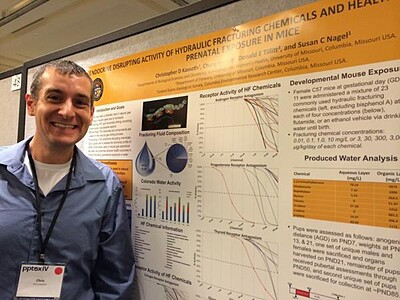Endocrine-disrupting chemicals, or EDCs, are synthetic or naturally occurring compounds that can interfere with or mimic the body’s hormones. EDCs, such as flame retardants, phthalates, and bisphenol A, are known for their potential effects on reproductive, neurological, and immune function. However, animal studies also suggest that early life exposure to some EDCs can contribute to weight gain and metabolic dysfunction. Obesity and metabolic disorders are a large societal concern and generate significant human health care costs.
Dr. Chris Kassotis’s work at Duke University has sought to evaluate the potential for diverse environmental contaminants to promote fat cell development, using an in vitro model of adipogenesis. These mouse pre-adipocytes, when exposed to "active" chemicals, differentiate into adipocytes, undergo morphological changes, accumulate triglycerides, and eventually come to resemble a mature human white fat cell. His recent work investigated 41 chemicals, from a variety of chemical classes, that are commonly detected in residential house dust. Among these contaminants, approximately two-thirds promoted significant fat cell development.
At 9am Pacific / noon Eastern on October 18, we learned more about this critical research and its implications. Dr. Kassotis also spoke about additional work using samples of indoor dust from 11 homes in North Carolina, examining whether mixtures of chemicals in the dust extracts were sufficient to promote cell differentiation at low, environmentally relevant levels.
Featured Speaker

Chris Kassotis, PhD, is a Postdoctoral Research Scholar in the Nicholas School of the Environment at Duke University. He completed his PhD at the University of Missouri working with Drs. Susan Nagel and Fred vom Saal to assess unconventional oil and gas operations as a novel source of endocrine disrupting chemicals in water, and the potential for adverse human and animal health outcomes from exposure. He is now working on an NRSA Fellowship in Dr. Heather Stapleton's lab at Duke to assess the ability of environmental contaminants, particularly complex chemical mixtures present in indoor house dust, to promote fat cell development. His current research aims to better understand the mechanisms through which these contaminants can promote fat cell development and aims to develop new assays to isolate and characterize novel endocrine disruptors in complex mixtures.
This webinar is one in a monthly series sponsored by the Collaborative on Health and the Environment’s EDC Strategies Partnership. The CHE EDC Strategies Partnership is chaired by Carol Kwiatkowski and Katie Pelch (TEDX), Sharyle Patton (Commonweal Biomonitoring Resource Center), Jerry Heindel (Commonweal Program on Endocrine Disruption Strategies), and Genon Jensen (HEAL) and coordinated by Maria Williams (Collaborative on Health and the Environment, a Commonweal program). To see a full list of past calls and webinars related to EDCs and listen to or view recordings, please visit our partnership page.
This webinar was moderated by Sharyle Patton, director of the Commonweal Biomonitoring Resource Center. It lasted for 30 minutes and was recorded for our call and webinar archive.
